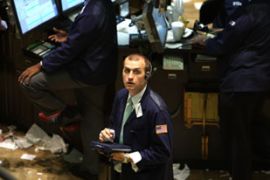Federal Reserve cuts interest rate
US stock markets soar after the half percentage point cut – the first in four years.

It had been held at 5.25 per cent since June 2006. Commercial banks followed quickly with announcements that they were slashing their prime lending rate by a half-point to 7.75 per cent.
Markets close up
The Dow Jones industrial average, which was up by 84 points just before the Fed’s decision, soared by more than 300 points following the mid-afternoon announcement.
The tech-heavy Nasdaq advanced 70.00 points (2.71 per cent) to 2,651.66.
| “I think the Fed delivered a healthy dose of monetary medicine to the economy and housing market”
Scott Anderson, senior economist at Wells Fargo |
“I think the Fed delivered a healthy dose of monetary medicine to the economy and housing market,” Scott Anderson, senior economist at Wells Fargo, said.
“I think it will be viewed as an aggressive move by the Fed to avert an economic recession.”
The central bank said it still believed the economy faced some risk of inflation, but said market developments since its last meeting in early August had increased the uncertainty surrounding the outlook.
“The committee will continue to assess the effects of these and other developments on economic prospects and will act as needed to foster price stability and sustainable economic growth,” it said.
Housing slump
The US is suffering its worst slump in the housing market in 16 years.
The downturn has triggered record defaults in subprime mortgages – high risk loans to borrowers with a poor credit history – and panicked financial markets around the globe as investors became worried about where the spreading credit problems would next appear.
 |
| The housing downturn has triggered record defaults on high-risk mortgages [AFP] |
Reports on retail sales and industrial output in August also showed some softness.
Ken Goldstein, an economist with the conference board, told Al Jazeera that there was unlikely to any discernible change in consumer confidence because of the Fed’s move.
“What really determines consumer confidence, at least within the United States, is what happens or doesn’t happen in the labour market,” he said.
“If the bad number in August simply turns out to be an aberration then I don’t really think you are going to see any big change in consumer confidence and therefore in terms of consumer spending.
“On the other hand if we get another bad report in September, I think there is indeed a danger here, we could see consumers turn more cautious. Not just US consumers, consumers across the industrial world.”